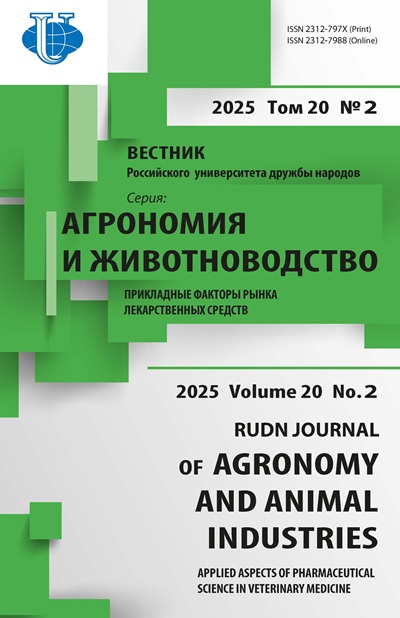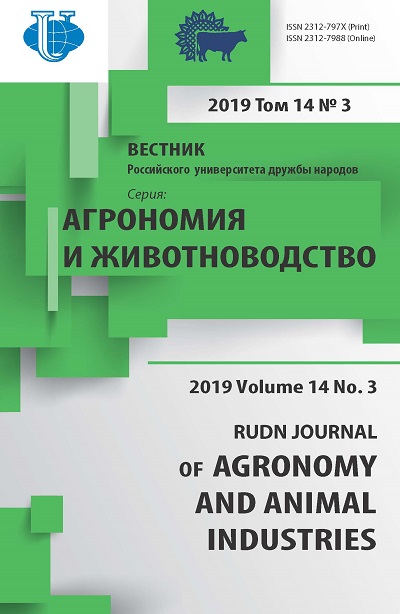Влияние комбинированного использования удобрений и ростостимулирующих бактерий Rhizobium, Azospirillum, Azotobacter и Pseudomonas на качество и состав кукурузного корма в Иране
- Авторы: Насерзаде Ю.1, Нафчи А.М.2, Махмуди Н.1, Нежад Д.К.3, Гаджикурбанов А.Ш.1
-
Учреждения:
- Российский университет дружбы народов
- Научный университет Малайзии
- Семнанский университет
- Выпуск: Том 14, № 3 (2019)
- Страницы: 209-224
- Раздел: Растениеводство
- URL: https://journal-vniispk.ru/2312-797X/article/view/329147
- DOI: https://doi.org/10.22363/2312-797X-2019-14-3-209-224
- ID: 329147
Цитировать
Полный текст
Аннотация
Для исследования влияния химических удобрений и ростостимулирующих бактерий на урожайность и качество зерна кукурузы ( Zea mays ) сорта 704 (одиночный кросс) был проведен факторный рандомизированный блочной эксперимент с тремя повторностями в 2017 г. Исследовательская ферма Варамин находится в Тегеране, Иран. Обработку семян стимулятором роста проводили в четырех комбинациях: Rhizobium , Azospirillum , Azotobacter и Pseudomonas ; Rhizobium , Azospirillum и Pseudomonas ; Rhizobium , Azotobacter и Pseudomonas ; Azospirillum , Azotobacter и Pseudomonas - на фоне применения азотных N и фосфорных P удобрений в четырех вариантах: без удобрений, 1/3, 2/3 и 100 % рекомендуемой концентрации. Результаты исследований показали, что использование удобрений оказало значительный эффект на такие параметры, как количество листьев на одно растение, количество семян в ряду, количество семян на колосе, высота растения и урожайность кормов на уровне 1 %. Лучшая кормовая урожайность 33,78 т/га была получена при кобинированном использовании удобрений и биологических ростостимулирующих препаратов на основе Rhizobium , Azospirillum , Azotobacter и Pseudomonas , что оказалось на 42 % выше, чем в контроле.
Ключевые слова
Об авторах
Юсеф Насерзаде
Российский университет дружбы народов
Автор, ответственный за переписку.
Email: unaserzadeh@gmail.com
аспирант, агробиотехнологический департамент, Аграрно-технологический институт
Москва, Российская ФедерацияАбдорреза Мохаммади Нафчи
Научный университет Малайзии
Email: niloofarmahmoodi@ymail.com
PhD candidate, Department of AgroBiotechnology
Пенанг, МалайзияНилоуфар Махмуди
Российский университет дружбы народов
Email: amohammadi@usm.my
профессор Школы пищевых технологий промышленных технологий
Москва, Российская ФедерацияДавуд Картули Нежад
Семнанский университет
Email: Kartooli58@gmail.com
доцент кафедры лесоводства, факультет исследований пустынь
Семнан, ИранАнвар Шихрагимович Гаджикурбанов
Российский университет дружбы народов
Email: gadcgikurbanow@mail.ru
агробиотехнологический департамент, Аграрнотехнологический институт
Москва, Российская ФедерацияСписок литературы
- López P, Casanova E, Chacon L, Paz P, Guerrero JR. Residual effect of three phosphate rocks from Tachina [Venezuela] in a greenhouse experiment with maize (Zea mays L.) as indicator plant. Revista Cientifica UNET. 1990; 4(1—2):29—48.
- Bostick WM, Bado VB, Bationo A, Soler CT, Hoogenboom G, Jones JW. Soil carbon dynamics and crop residue yields of cropping systems in the Northern Guinea Savanna of Burkina Faso. Soil and Tillage Research. 2007; 93(1):138—151. doi: 10.1016/j.still.2006.03.020
- Sarkar S, Singh SR, Singh RP. The effect of organic and inorganic fertilizers on soil physical condition and the productivity of a rice–lentil cropping sequence in India. The Journal of Agricultural Science. 2003; 140(4):419—425. doi: 10.1017/S0021859603003186
- Tittonell P, Giller KE. When yield gaps are poverty traps: The paradigm of ecological intensification in African smallholder agriculture. Field Crops Research. 2013; 143:76—90. Available from: doi: 10.1016/j.fcr.2012.10.007
- Zimmerer KS. The compatibility of agricultural intensification in a global hotspot of smallholder agrobiodiversity (Bolivia). Proceedings of the National Academy of Sciences. 2013; 110(8):2769—2774. doi: 10.1073/pnas.1216294110
- Kumar A, Patel JS, Bahadur I, Meena VS. The molecular mechanisms of KSMs for enhancement of crop production under organic farming. In: Potassium solubilizing microorganisms for sustainable agriculture. New Delhi: Springer; 2016. p.61—75. doi: 10.1007/978-81-322-2776-2_5
- Naserzadeh Y, Kartoolinejad D, Mahmoudi N, Zargar M, Pakina E, Heydari M, et al. Nine strains of Pseudomonas fluorescens and P. putida: Effects on growth indices, seed and yield production of Carthamus tinctorius L. Research on Crops. 2018; 19(4):622—632. doi: 10.31830/2348-7542.2018.0001.39
- Vessey JK. Plant growth promoting rhizobacteria as biofertilizers. Plant and soil. 2003; 255(2):571—586. doi: 10.1023/A:1026037216893
- Jat LK, Singh YV, Meena SK, Meena SK, Parihar M, Jatav HS, et al. Does integrated nutrient management enhance agricultural productivity. Pure Appl Microbiol. 2015; 9(2):1211—1221.
- Naserzadeh Y, Mahmoudi N. Chelating Effect of Black Tea Extract Compared to Citric Acid in the Process of the Oxidation of Sunflower, Canola, Olive, and Tallow oils. International Journal of Agricultural and Biosystems Engineering. 2018; 12(5). DOI: 10.13140/ RG.2.2.12552.26887
- Wu S, Cao Z, Li Z, Cheung K, Wong MH. Effects of biofertilizer containing N-fixer, P and K solubilizers and AM fungi on maize growth: a greenhouse trial. Geoderma. 2005; 125(1— 2):155—166. doi: 10.1016/j.geoderma.2004.07.003
- Parewa HP, Yadav J, Rakshit A. Effect of fertilizer levels, FYM and bioinoculants on soil properties in inceptisol of Varanasi, Uttar Pradesh, India. International Journal of Agriculture, Environment and Biotechnology. 2014; 7(3):517. doi: 10.5958/2230-732X.2014.01356.4
- Shata SM, Mahmoud A, Siam S. Improving calcareous soil productivity by integrated effect of intercropping and fertilizer. Research Journal of Agriculture and Biological Sciences. 2007; 3(6):733—739.
- Zahir ZA, Arshad M, Frankenberger WT. Plant growth promoting rhizobacteria: applications and perspectives in agriculture. Advances in Agronomy. 2004; 81(1):98—169.
- Tien T, Gaskins M, Hubbell D. Plant growth substances produced by Azospirillum brasilense and their effect on the growth of pearl millet (Pennisetum americanum L.). Appl. Environ. Microbiol. 1979; 37(5):1016—1024.
- Lambrecht M, Okon Y, Broek AV, Vanderleyden J. Indole-3-acetic acid: a reciprocal signalling molecule in bacteria–plant interactions. Trends in microbiology. 2000; 8(7):298— 300. doi: 10.1016/S0966-842X(00)01732-7
- Ahemad M, Kibret M. Mechanisms and applications of plant growth promoting rhizobacteria: current perspective. Journal of King Saud University — science. 2014; 26(1):1—20. doi: 10.1016/j.jksus.2013.05.001
- Krystofova O, Shestivska V, Galiova M, Novotny K, Kaiser J, Zehnalek J, et al. Sunflower plants as bioindicators of environmental pollution with lead (II) ions. Sensors. 2009; 9(7):5040—5058. doi: 10.3390/s90705040
- Hernández-Rodríguez A, Heydrich-Pérez M, Acebo-Guerrero Y, Velazquez-Del Valle MG, Hernandez-Lauzardo AN. Antagonistic activity of Cuban native rhizobacteria against Fusarium verticillioides (Sacc.) Nirenb. in maize (Zea mays L.). Applied soil ecology. 2008; 39(2):180—186. doi: 10.1016/j.apsoil.2007.12.008
- Radha TK, Rao DLN. Plant growth promoting bacteria from cow dung based biodynamic preparations. Indian journal of microbiology. 2014; 54(4):413—418. doi: 10.1007/s12088014-0468-6
- Grönemeyer JL, Kulkarni A, Berkelmann D, Hurek T, Reinhold-Hurek B. Rhizobia indigenous to the Okavango region in Sub-Saharan Africa: diversity, adaptations, and host specificity. Appl. Environ. Microbiol. 2014; 80(23):7244—7257. doi: 10.1128/AEM.02417-14
- Hernandez AN, Hernandez A, Heydrich M. Selection of rhizobacteria for use in maize cultivation. Cultivos Tropicales. 1995; 6:5—8.
- Tilak KVBR, Singh CS, Roy NK, Subba Rao NS. Azospirillum brasilense and Azotobacter chroococcum inoculum: effect on yield of maize (Zea mays) and sorghum (Sorghum bicolor). Soil Biology and Biochemistry. 1982; 14(4): 417—418. doi: 10.1016/0038-0717(82)90016-5
- Almaghrabi OA, Massoud SI, Abdelmoneim TS. Influence of inoculation with plant growth promoting rhizobacteria (PGPR) on tomato plant growth and nematode reproduction under greenhouse conditions. Saudi journal of biological sciences. 2013; 20(1):57—61. doi: 10.1016/j.sjbs.2012.10.004
- Kohler J, Hernández JA, Caravaca F, Roldán A. Induction of antioxidant enzymes is involved in the greater effectiveness of a PGPR versus AM fungi with respect to increasing the tolerance of lettuce to severe salt stress. Environmental and Experimental Botany. 2009; 65(2—3):245—252. doi: 10.1016/j.envexpbot.2008.09.008
- Jäderlund L, Arthurson V, Granhall U, Jansson JK. Specific interactions between arbuscular mycorrhizal fungi and plant growth-promoting bacteria: as revealed by different combinations. FEMS microbiology letters. 2008; 287(2):174—180. doi: 10.1111/j.15746968.2008.01318.x
- Zahir A, Arshad M, Khalid A. Improving maize yield by inoculation with plant growth promoting rhizobacteria. Pakistan Journal of Soil Science. 1998; 15:7—11.
- Belimov AA, Safronova VI, Sergeyeva TA, Egorova TN, Matveyeva VA, Tsyganov VE, et al. Characterization of plant growth promoting rhizobacteria isolated from polluted soils and containing 1-aminocyclopropane-1-carboxylate deaminase. Canadian Journal of Microbiology. 2001; 47(7):642—652. doi: 10.1139/w01-062
- Soleimanzadeh H, Habibi D, Ardakani M, Paknejad F, Rejali F. Response of sunflower (Helianthus annuus L.) to inoculation with Azotobacter under different nitrogen levels. AmericanEurasian Journal of Agricultural and Environmental Science. 2010; 7(3):265—268.
- Fulchieri M, Frioni L. Azospirillum inoculation on maize (Zea mays): effect on yield in a field experiment in central Argentina. Soil Biology and Biochemistry. 1994; 26(7):921— 923. doi: 10.1016/0038-0717(94)90308-5
- Rohitashav-Singh S, Sharma VK, Singh R. Response of forage maize (Zea mays L.) to Azotobacter inoculation and nitrogen. Indian J. Agronomy. 1993; 38:555—558.
- Ferrise R, Triossi A, Stratonovitch P, Bindi M, Martre P. Sowing date and nitrogen fertilisation effects on dry matter and nitrogen dynamics for durum wheat: An experimental and simulation study. Field Crops Research. 2010; 117(2—3):245—257. doi: 10.1016/j.fcr.2010.03.010
- Chabot R, Antoun H, Cescas MP. Stimulation de la croissance du maïs et de la laitue romaine par des microorganismes dissolvant le phosphore inorganique. Canadian journal of microbiology. 1993; 39(10):941—947. doi: 10.1139/m93-142
- Peiffer JA, Ley RE. Exploring the maize rhizosphere microbiome in the field: a glimpse into a highly complex system. Communicative & integrative biology. 2013; 6(5):e25177. doi: 10.4161/cib.25177
Дополнительные файлы











